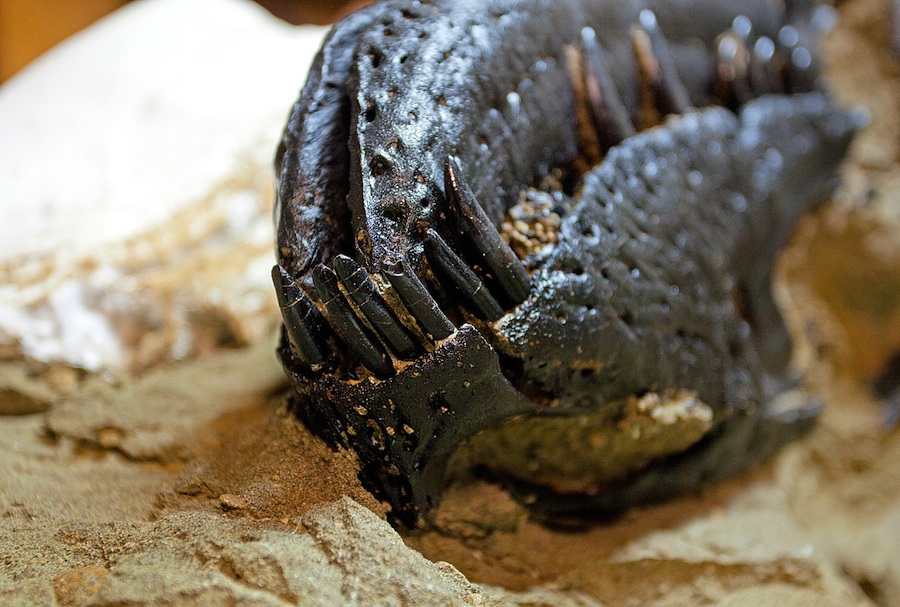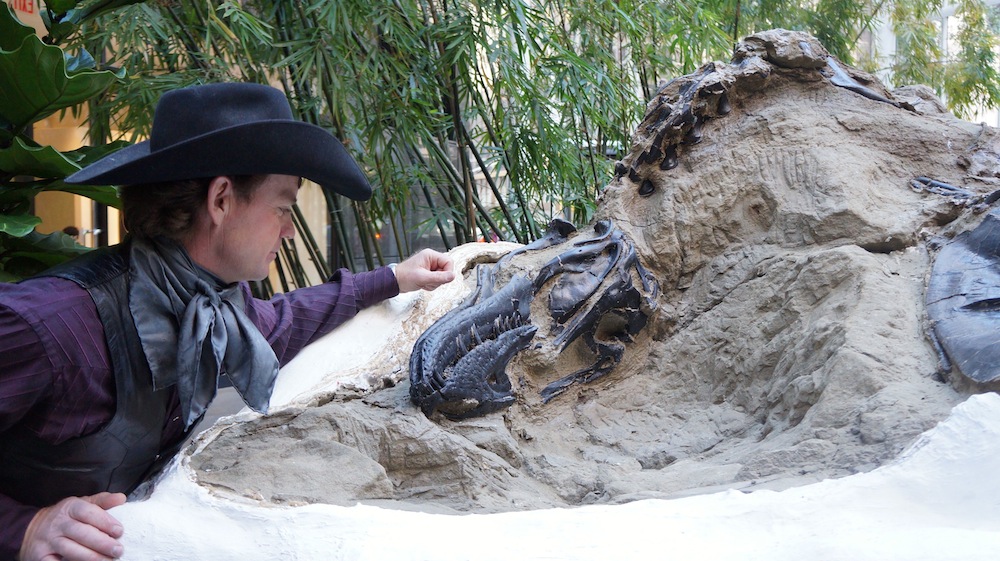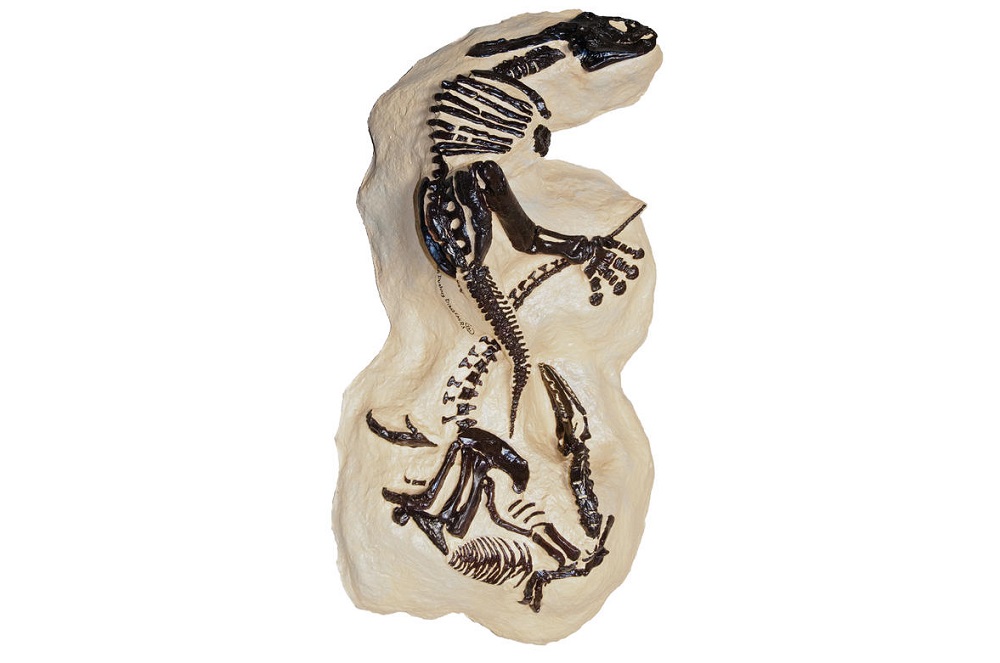'Dueling Dinosaurs' Await Auction Fate

NEW YORK — Seven years ago, two amazingly complete dinosaurs were discovered in a shared grave in Montana. One, a clunky Triceratops-like creature, was partially draped over the other, a scrappy tyrannosaurid with its skull crushed in and many of its teeth broken off.
It's been purported that the beasts fought each other to the death 67 million years ago, and before scavengers could have their way with the corpses, some force of nature buried the combatants in sand, immortalizing them in their battle pose.
Or, perhaps aliens arranged them that way, paleontologist Jack Horner quipped.
Horner's point is that scientists just can't be sure yet, because the dinosaurs haven't been put up for a rigorous peer review. Rather, they've been put up for auction and are estimated to sell for up to $9 million next week here on Madison Avenue. [See Images of the Dueling Dinosaurs]
Anxiety looms that the specimens might be lost to science when they go under the auction hammer, demonstrating how fossils — even well-articulated, legally acquired ones like the so-called Montana Dueling Dinosaurs — are sometimes shunned by paleontologists when they're offered in high-profile commercial sales.
A rare discovery
Still encased in dirt and their plaster field jackets, the Dueling Dinosaurs are hardly display-ready. The massive chunks of the specimen are now on view here, roped off and surrounded by potted plants inside of the atrium at the former I.B.M. building, next to the galleries at the auction house Bonhams.
Sign up for the Live Science daily newsletter now
Get the world’s most fascinating discoveries delivered straight to your inbox.
Wearing a dark cowboy hat and a vest, the dinosaurs' discoverer, Clayton Phipps, is easy to pick out in a crowd of New Yorkers. A longtime rancher who has been fossil-hunting in the Montana badlands for 12 years, Phipps has earned the nickname the "Dinosaur Cowboy." He said searching for bones started out as a hobby, but that changed when he found and sold the skull of a Stygimoloch spinifer, a dinosaur whose name means "horned devil from the river of death."

"The sale from that gave me about a year's wages," Phipps said. "I told my wife, 'I'm gonna take a year and see if we can survive.'"
Phipps found the first hint of the Dueling Dinosaurs in 2006, when he and two others spotted a pelvis bone eroding out of a canyon on a neighbor's ranch.
"My hope was that we had half of one dinosaur," Phipps told LiveScience. In following the bone trail, Phipps and his crew discovered a near-complete ceratopsid, a type of plant-eating dinosaur with a bony frill. While excavating that animal's tail, the fossil preparators discovered the tyrannosaurid. [Images: Big-Nosed Ceratopsid Dinosaur Discovered]
"When we found that guy, I threw my hat into the air," Phipps said.
Bonhams, which has estimated the fossils will sell for $7-9 million, has billed the pair as the most complete dinosaurs ever to be found in the Late Cretaceous rocks of North America.
Battle for data
The claim that the dinosaurs died locked in a fierce death match has been particularly irksome to some scientists.
"Fossil dealers have in the past presented the more sensational of a range of interpretations of their finds to boost price," explained Pete Makovicky, a curator specializing in dinosaurs at The Field Museum in Chicago, "so there needs to be a careful evaluation of the evidence."
But not everyone is so suspicious. Paleontologist Robert Bakker, of the Houston Museum of Natural Science, said he was among the Dueling Dinosaurs' naysayers until he went to Montana to look at the specimens himself.
"If this were a 'Law and Order' episode, you could bring the case to the district attorney," Bakker said.
"They're really good. These were taken out with great care," he added. "These guys knew what they were doing."
Bakker was impressed with many of the same things Phipps pointed out in New York: a tyrannosaurid tooth seemingly stuck into the neck of the bulky herbivore; traces of dinosaur skin on the frill of the ceratopsid; the clean sand surrounding the bones; and the tyrannosaurid's huge forearms and fingers.

The tyrannosaurid has been labeled a Nanotyrannus lancensis. Other, more fragmentary pieces of that dinosaur have been found before, but there has been debate about whether it actually represents a distinct species or a juvenile Tyrannosaurus rex in its awkward stage.
The Dueling Dinosaurs hold promise to shed light on that debate. But if the specimens end up in the hands of a private buyer, and not a public collection, scientists who would want to study the fossils might run into some ethical quandaries within their field since their data wouldn't be openly available for others to study. The same is often true for researchers studying meteorites, antiquities and any other rare materials that double as data points and collectors' items.
As Michael Benton, a professor of vertebrate paleontology at the University of Bristol, told The Guardian : "Nearly all scientific journals require that specimens studied scientifically and published must be freely available for further study by others, and this means an accessible, public collection. This is a basic tenet of science: the need to make all published work repeatable."
No sugar daddies for dinosaurs
Many paleontologists don't have a problem with landowners selling fossils, though they would rather not put a price tag on objects whose value they measure in terms of knowledge and natural heritage. Some fear that the kind of person who would pay such a high price for the Dueling Dinosaurs wouldn't necessarily donate them to a natural history museum.
"We're not like an art museum where you have sugar mommies and daddies who buy these things for you," said Hans-Dieter Sues, curator of vertebrate paleontology at the Smithsonian's National Museum of Natural History. "In the natural history world, that's just not the case. We don't have that kind of donorship."
And museums might be better off investing in research instead of buying already-found fossils, explained Horner, who works at Montana State University.
"Over the past 12 years, I have collected more than 100 Triceratops specimens, a dozen Tyrannosaurus specimens and hundreds of other specimens, all with detailed scientific data, for the mere cost of $2,000,000," Horner wrote in an email. "All museums would be much better off to hire a paleontologist, and give them $1,000,000 and send them out to collect for a few years." [Photos: A Tyrannosaur Travels from Auction to Courtroom]
Phipps had previously tried to sell the pair of dinosaurs to an American museum, but no one bit. (Sues said the Smithsonian was asked if they wanted to buy the fossils for $15 million.) And Phipps said he had his own qualms about the auction, noting he's often turned over in his mind the possibility that the creatures would end up locked away in a mansion.
"When Bonhams contacted me and asked if I would like to put them in the sale, I was torn, because we have no control over what happens to them at this point," Phipps told LiveScience. "When we first found them I tried to figure out a way to keep them local, but the money wasn't there to study them. The money wasn't there to curate them."
Phipps lives in a remote part of Montana that he says is 30 miles away from the closest town of 300 people and another 80 miles from a town of 9,000 people. "To get the money for us locally to keep them there was not feasible," he said.
"It's my sincere hope that a museum will end up with them with the financial means to study them and do all the scientific work," Phipps said.
The sale at Bonhams will take place on Tuesday, Nov. 19, at 1:00 p.m. ET.
Follow Megan Gannon on Twitter and Google+. Follow us @livescience, Facebook & Google+. Original article on LiveScience.










